Assessment of Dredging Scenarios for a Tidal Inlet in a High-Energy Coast
Abstract
1. Introduction
- (1)
- to assess the morphodynamic response of the tidal inlet, that is subjected to dredging operations, under winter wave climate conditions;
- (2)
- to compare the obtained results with natural evolution (i.e., no-dredging operations);
- (3)
- to improve the knowledge about the parameters that contribute to sediment infill of dredging operations;
- (4)
- to evaluate the effectiveness of dredging configuration (i.e., area and volume), that guarantees a bed level to safe navigation, under current wave climate conditions.
2. Study Area
3. Methods
3.1. Delft3D Model Setup
3.2. Dredging Scenarios
3.3. Wave Climate Data
3.4. Simulations
4. Results
4.1. Bathymetry Evolution in Dredging Area and Tidal Inlet Mouth Entrance
4.2. Dredging Scenarios Lifetime
4.2.1. Dredging Scenarios Lifetime under Propagated Wave Climate
4.2.2. Dredging Scenarios’ Lifetime under Wave Climate Conditions (1958–2017)
5. Discussion
6. Conclusions
- (1)
- The response of the tidal inlet morphodynamic for three-month winter period under winter wave climate conditions after dredging operations was shown.
- (2)
- The results obtained under natural evolution (i.e., no-dredging operations) were compared with those of dredging operations. This disclosed that dredging operations slowed down the development of a submerged sandbar extending southwards from the head of the north jetty.
- (3)
- A better understanding of the underlying factors that play a role in the sediment infill of dredging operations at wave-dominated inlets was provided, revealing the link between sediment infill and wave climate conditions, as well as with sedimentation basin configuration.
- (4)
- The effectiveness of dredging configurations was assessed. This highlighted that dredging operations performing updrift of the tidal inlet prevent a quick shoaling at the tidal inlet mouth entrance that could promote safe navigation towards the inlet. Nevertheless, the dredging operation effectiveness depends on wave energy and sedimentation basin configuration (i.e., area and volume).
Supplementary Materials
Author Contributions
Funding
Acknowledgments
Conflicts of Interest
References
- Hayes, M.O. General morphology and sediment patterns in tidal inlets. Sediment. Geol. 1980, 26, 139–156. [Google Scholar] [CrossRef]
- FitzGerald, D.M. Geological controls on tidal inlets. Shore Beach 2015, 83, 59–64. [Google Scholar]
- Bertin, X.; Fortunato, A.B.; Oliveira, A. A modeling-based analysis of processes driving wave-dominated inlets. Cont. Shelf Res. 2009, 29, 819–834. [Google Scholar] [CrossRef]
- Fortunato, A.B.; Nahon, A.; Dodet, G.; Pires, A.R.; Freitas, M.C.; Bruneau, N.; Azevedo, A.; Bertin, X.; Benavides, P.; Andrade, C.; et al. Morphological evolution of an ephemeral tidal inlet from opening to closure: The Albufeira inlet, Portugal. Cont. Shelf Res. 2014, 73, 49–63. [Google Scholar] [CrossRef]
- Karunarathna, H.; Horrillo-Caraballo, J.; Burningham, H.; Pan, S.; Reeve, D.E. Two-dimensional reduced-physics model to describe historic morphodynamic behaviour of na estuary inlet. Mar. Geol. 2016, 382, 200–209. [Google Scholar] [CrossRef]
- Doré, A.; Bonetton, P.; Marieu, V.; Garlain, T. Observation and numerical modeling of tidal dune dynamics. Ocean Dyn. 2018, 68, 589–602. [Google Scholar] [CrossRef]
- Kieslich, J.M. Tidal Inlet Response to Jetty Construction; Technical Report for US Army Engineer Waterways Experiment Station Hydraulics Laboratory; US Army Engineer Waterways Experiment Station Hydraulics Laboratory: Vicksburg, MS, USA, 1981. [Google Scholar]
- Angulo, R.J.; de Souza, M.C.; Lamour, M.R. Coastal erosion problems induced by dredging activities in the navigation channel of Paranaguá and São Francisco do Sul harbor, southern Brazil. J. Coast. Res. 2006, 39, 1801–1803. [Google Scholar]
- Pacheco, A.; Carrasco, A.R.; Vila-Concejo, A.; Ferreira, O.; Dias, J.A. Recent evolution of Faro channel and its association to dredging operations (Algarve, Portugal). J. Coast. Res. 2006, 39, 572–577. [Google Scholar]
- Castelle, B.; Turner, I.; Bertin, X.; Tomlinson, R. Beach nourishment at Coollangatta Bay (Australia) over the period 1987–2005: Impacts and lessons. Coast. Eng. 2009, 59, 940–950. [Google Scholar] [CrossRef]
- Dabees, M.; Moore, B.D. Evaluation of inlet management practices at navigation inlets in southwest Florida, USA. In Proceedings of the 32nd Conference on Coastal Engineering, Shanghai, China, 30 June–5 July 2010. [Google Scholar]
- Garel, E.; Sousa, C.; Ferreira, O.; Morales, J.A. Decadal morphological response of an ebb-tidal delta and down-drift beach to artificial breaching and inlet stabilisation. Geomorphology 2014, 216, 13–25. [Google Scholar] [CrossRef]
- Leys, V.; Lehmann, M. Multi-inlet migration modeling for navigation cannel management in Tubusintuc Bay, Eastern Canada. In Proceedings of the 35th Conference on Coastal Engineering, Antalya, Turkey, 17–20 November 2016; Lynett, P., Ed.; [Google Scholar] [CrossRef][Green Version]
- Ramli, A.Y. The Impact of Dredging on the Stability of the Matakana Banks Ebb-Tidal Delta. Ph.D. Thesis, University of Waikato, Hamilton, New Zealand, 2016. [Google Scholar]
- Hayes, M.O.; FitzGerald, D.M. Origin, Evolution, and Classification of Tidal Inlets. J. Coast. Res. 2013, 69, 14–33. [Google Scholar] [CrossRef]
- Sennes, G.; Castelle, B.; Bertin, X.; Mirfenderesk, H.; Tomlinson, R.B. Modelling of the Gold Coast Seaway tidal inlet, Australia. J. Coast. Res. 2007, 50, 1086–1091. [Google Scholar]
- Logan, S.J.; Nistor, I.; Cornett, A.; Faure, T.; Drouin, A. Morphological modeling of highly dynamic tidal inlet at Shippagan Gully, Canada. In Proceedings of the 33th Conference on Coastal Engineering, Santander, Spain, 1–6 July 2012; Lynett, P., McKee Smith, J., Eds.; [Google Scholar] [CrossRef]
- Mendes, D.S.; Fortunato, A.B.; Pires-Silva, A.A. Assessment of three dredging plans for a wave-dominated inlet. Proc. Inst. Civil Eng. Mar. Eng. 2016, 169, 64–75. [Google Scholar] [CrossRef][Green Version]
- Reyes-Merlo, M.A.; Ortega-Sánchez, M.; Díez-Minguito, M.; Losada, M.A. Efficient dredging strategy in a tidal inlet based on an energetic approach. Ocean Coast. Manag. 2017, 146, 157–169. [Google Scholar] [CrossRef]
- Shaeri, S.; Tomlinson, R.; Etemad-Shahidi, A.; Strauss, D. Numerical modelling to assess maintenance strategy management options for a small tidal inlet. Estuar. Coast. Shelf Sci. 2017, 187, 273–292. [Google Scholar] [CrossRef]
- Fairbridge, R.H. The estuary: Its definition and geodynamic cycle. In Chemistry and Biogeochemistry of Estuaries; Olausson, E., Cato, I., Eds.; Willey: New York, NY, USA, 1980; pp. 1–16. ISBN 978-047-12-7679-1. [Google Scholar]
- Cunha, P.P.; Dinis, J. Sedimentary dynamics of the Mondego estuary. In Aquatic Ecology of the Mondego River Basin: Global Importance of Local Experience; Graça, M.A., Pardal, M.A., Marques, J.C., Eds.; University of Coimbra Press: Coimbra, Portugal, 2002; pp. 43–63. ISBN 978-989-26-0336-0. [Google Scholar]
- Plecha, S.; Silva, P.A.; Oliveira, A.; Dias, J.M. Establishing the wave climate influence on the morphodynamics of a coastal lagoon inlet. Ocean Dyn. 2012, 62, 799–814. [Google Scholar] [CrossRef]
- Oliveira, T.C.A.; Neves, M.G.; Fidalgo, R.; Esteves, R. Variability of wave parameters and Hmax/Hs relationship under storm conditions offshore the Portuguese continental coast. Ocean Eng. 2018, 153, 10–22. [Google Scholar] [CrossRef]
- Larangeiro, S.H.C.D.; Oliveira, F.S.B.F.; Freire, P.M.S. Longshore sediment transport along a sandy coast with hard rock outcrops. Shore Beach 2003, 71, 20–24. [Google Scholar]
- Silva, A.N.; Taborda, R.; Bertin, X.; Dodet, G. Seasonal to Decadal Variability of Longshore Sand Transport at the Northwest Coast of Portugal. J. Waterw. Port. Coast. 2012, 138, 464–472. [Google Scholar] [CrossRef]
- Santos, F.D.; Lopes, A.M.; Moniz, G.; Ramos, L.; Taborda, R. Gestão da Zona Costeira: O Desafio da Mudança; Relatório do Grupo de Trabalho do Litoral: Lisbon, Portugal, 2014. [Google Scholar]
- Cunha, P.P.; Dinis, J. Beach erosion between cabo Mondego and Figueira da Foz (Portugal Midwest), from 1995 to 1998. Territorium 1998, 5, 31–50. [Google Scholar] [CrossRef]
- Cunha, P.P.; Pinto, J.; Dinis, J.L. Evolução da fisiografia e ocupação antrópica na área estuarina do Rio Mondego e região envolvente (Portugal centro-oeste), desde 1947. Territorium 1997, 4, 99–124. [Google Scholar] [CrossRef]
- IPTM-Instituto Portuário e dos Transportes Marítimos; I.P.; Prolongamento do Molhe Norte do Porto da Figueira da Foz: Relatório, Portugal, 2011.
- Kraus, N.C. Reservoir Model for Calculating Natural Sand Bypassing and Change in Volume of Ebb-Tidal Shoals. In Part I: Description (ERDC/CHL CHETN-IV-39); Report; US Army Corps of Engineers, Engineer Research and Development Center, Coastal and Hydraulics Laboratory: Vicksburg, MS, USA, 2002. [Google Scholar]
- Romão, S.; Silva, P.A.; Baptista, P.; Fontán-Bouzas, A.; Fernández-Fernández, S.; Ferreira, C.; Bernardes, C.; Coelho, C.; Garrido, C.; Rua, J. Efeito da agitação marítima na morfologia de uma embocadura sujeita a dragagens. In Dragagens: Questões Ambientais e Monitorização, 1st ed.; Coelho, C., Silva, P.A., Pinheiro, L.M., Gonçalves, D.S., Eds.; University of Aveiro Press: Aveiro, Portugal, 2018; pp. 111–118. ISBN 978-972-789-535-9. [Google Scholar]
- Lesser, G.R.; Roelvink, J.A.; van Kester, J.A.T.M.; Stelling, G.S. Development and validation of a three-dimensional morphological model. Coast. Eng. 2004, 51, 883–915. [Google Scholar] [CrossRef]
- Ferreira, C.; Silva, P.A.; Fernández-Fernández, S.; Ribeiro, A.S.; Abreu, T.; Bertin, X.; Dias, J.M.D. Validation of a morphodynamic model to Figueira da Foz inlet. In Proceedings of the International Short Course and Conference on Applied Coastal Research-SCACR, Santander, Spain, 3–6 October 2017; Losada, I.J., Lara, J.L., Tomasichio, G.R., D’Alessandro, F., Eds.; pp. 1–12. [Google Scholar]
- Bertin, X.; Prouteau, E.; Letetrel, C. A significant increase in wave height in the North Atlantic Ocean over the 20th century. Glob. Planet. Chang. 2013, 106, 77–83. [Google Scholar] [CrossRef]
- Barstow, S.F.; Haug, O. Wave Data Collection on the Coast of Portugal in the MAST WAVEMOD Project; Technical Report for OCEANOR; OCEANOR: Trondheim, Norway, 1994. [Google Scholar]
- Mentaschi, L.; Besio, G.; Cassola, F.; Mazzino, A. Problems in RMSE-based wave model validations. Ocean Model. 2013, 72, 53–58. [Google Scholar] [CrossRef]
- Hanna, S.; Heinold, D. Development and Application of a Simple Method for Evaluating Air Quality; No. 4409; API Pub.: Philadelphia, PA, USA, 1985. [Google Scholar]
- Bijker, E.W. Longshore transport computations. J. Waterw. Harb. Coast. Eng. 1971, 97, 687–701. [Google Scholar]
- Soulsby, R. Dynamics of Marine Sands, a Manual for Practical Applications; Thomas Telford: London, UK, 1997; ISBN 072772584X. [Google Scholar]
- Van Rijn, L. Principles of Sediment Transport in Rivers, Estuaries and Coastal Seas; Aqua Publications: Amsterdam, The Netherlands, 1993; ISBN 90-800356-2-9. [Google Scholar]
- Van Rijn, L.C.; Walstra, D.J.R.; van Ormondt, M. Description of TRANSPOR2004 and Implementation in Delft3D-ONLINE; Technical Report for Delft Hydraulics; Delft Hydraulics: Delft, The Netherlands, 2004; pp. 237–239. [Google Scholar]
- Walstra, D.J.R.; van Ormondt, M.; Roelvink, J.A.; van Rijn, L.C. Shoreface Nourishment Scenarios: Detailed Morphodynamic Simulations with Delft3D for Various Shoreface Nourishment Designs; Technical Report for Delft Hydraulics; Delft Hydraulics: Delft, The Netherlands, 2004. [Google Scholar]
- Sutherland, J.; Peet, A.H.; Soulsby, R.L. Evaluating the performance of morphological models. Coast. Eng. 2004, 51, 917–939. [Google Scholar] [CrossRef]
- Seabergh, W.C. Weir Jetties at Coastal Inlets: Part 1, Functional Design Considerations (ERDC/CHL CHETN-IV-53); US Army Corps of Engineers, Engineer Research and Development Center, Coastal and Hydraulics Laboratory: Vickburg, MS, USA, 2002. [Google Scholar]
- Spanish National Harbour Authority. Conjunto de Datos SIMAR; Technical Report for Puertos del Estado; Puertos del Estado: Madrid, Spain, 2015; Available online: http://calipso.puertos.es//BD/informes/INT_8.pdf (accessed on 11 October 2019).
- Cahill, B.; Lewis, T. Wave period ratios and the calculation of wave power. In Proceedings of the 2nd Marine Energy Technology Symposium-METS2014, Seattle, WA, USA, 15–17 April 2014. [Google Scholar]
- Dolan, R.; Davies, R.E. Coastal storm hazards. J. Coast. Res. 1994, 12, 103–114. [Google Scholar]
- Herrling, G.; Winter, C. Tidal inlet sediment bypassing at mixed-energy barrier islands. Coast. Eng. 2018, 140, 342–354. [Google Scholar] [CrossRef]
- Hopkins, J.; Elgar, S.; Raubenheimer, B. Storm impact on morphological evolution of a sandy inlet. J. Geophys. Res. Oceans 2018, 123, 5751–5762. [Google Scholar] [CrossRef]
- Fernández-Fernández, S.; Silva, P.A.; Ferreira, C.; Ribeiro, A.S.; Abreu, T.; Romão, S.; Baptista, P.; Fontán-Bouzas, A.; Dias, J.M.; Coelho, C.; et al. Assessment of dredging/dumping scenarios for Figueira da Foz coastal region (W Portugal). J. Coast. Res. 2018, 85, 1266–1270. [Google Scholar] [CrossRef]
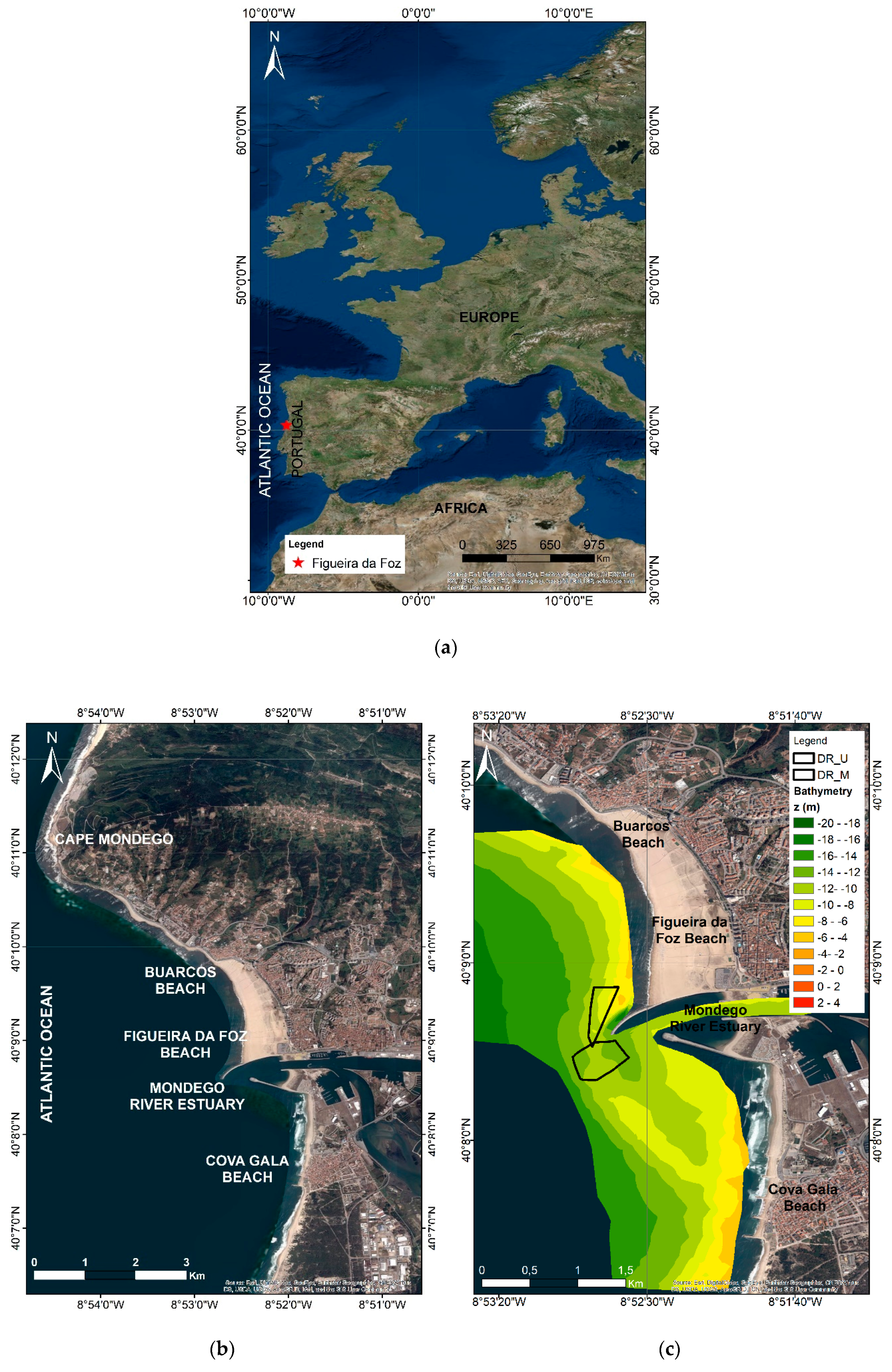

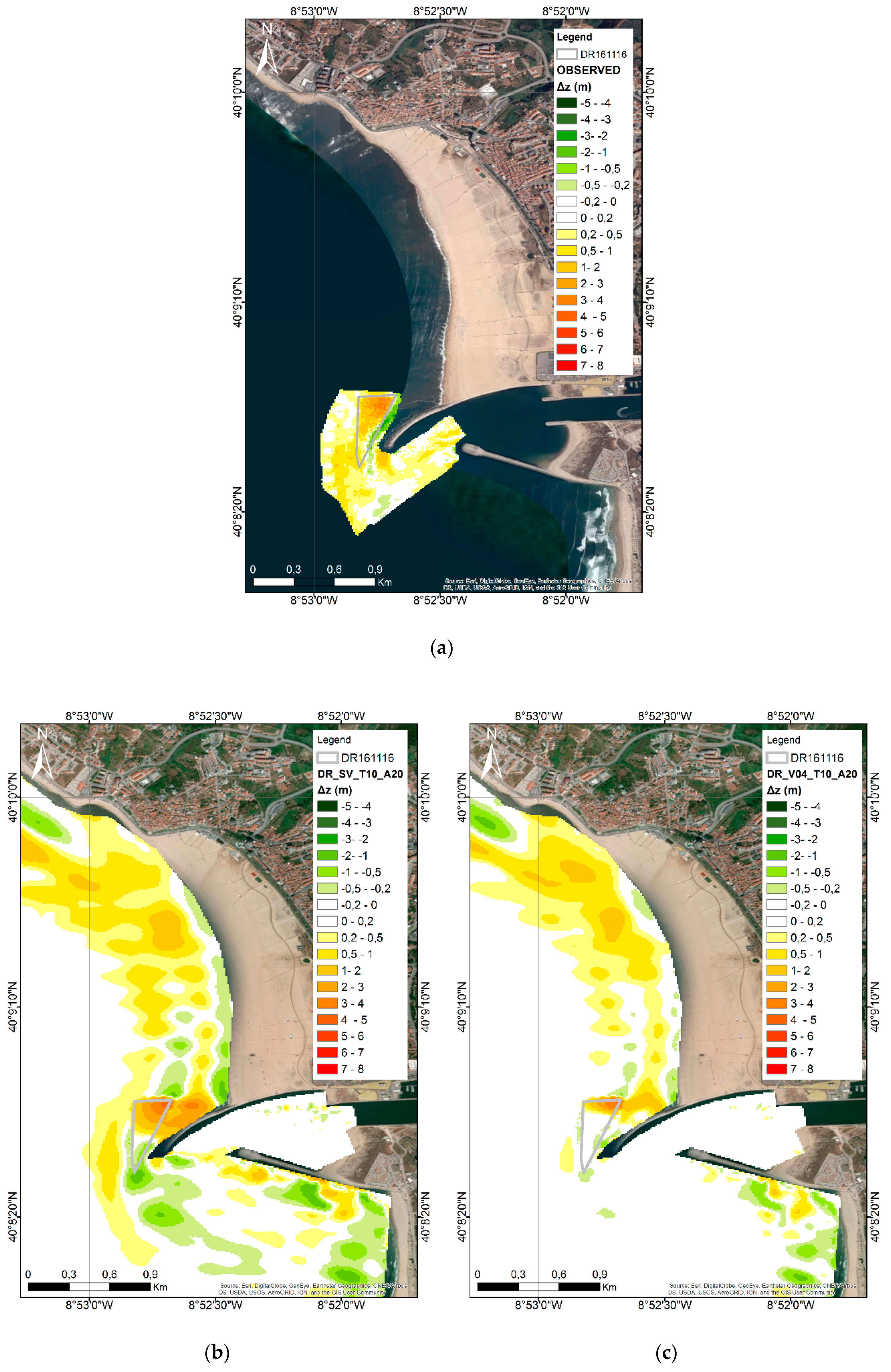

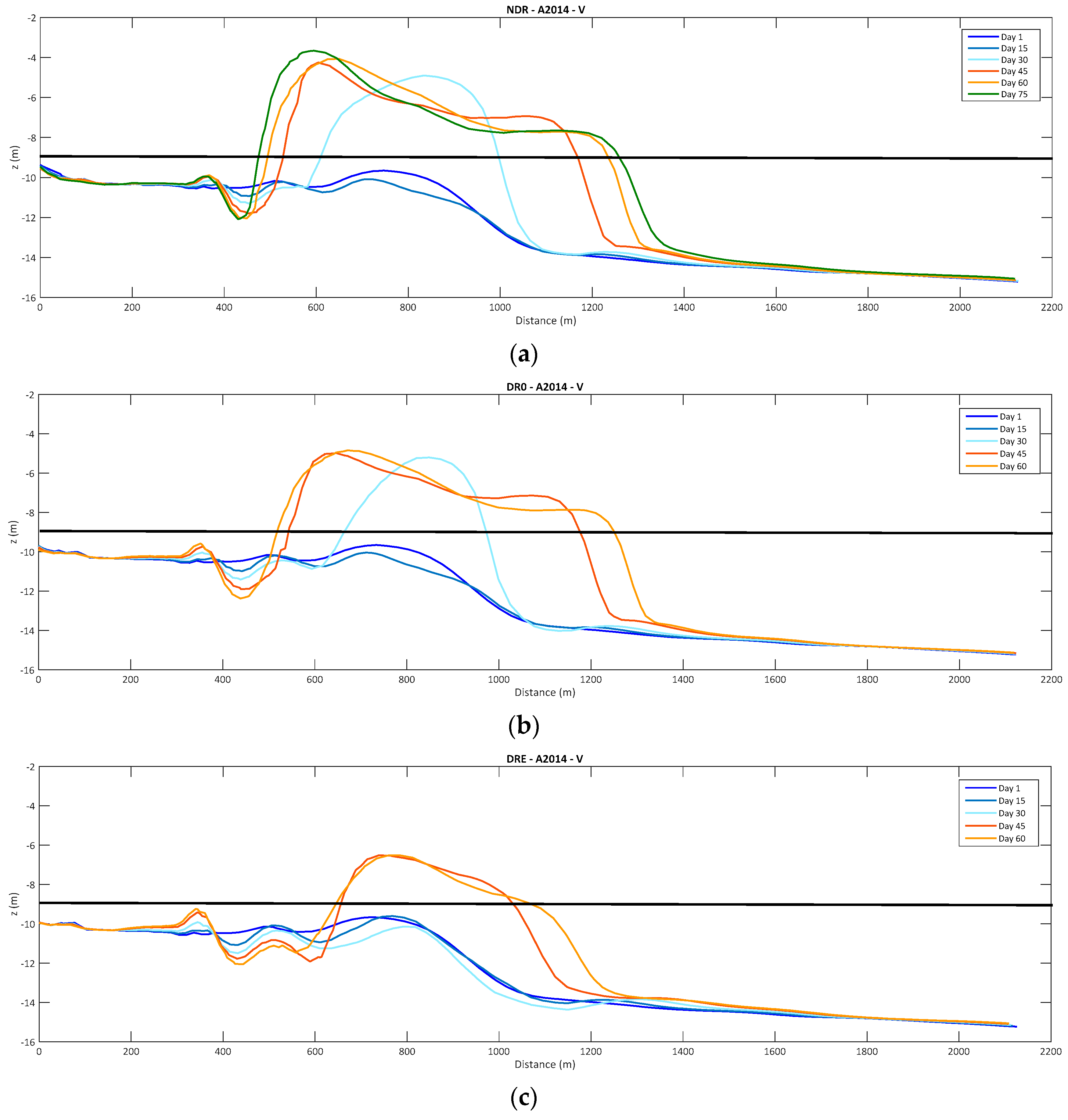
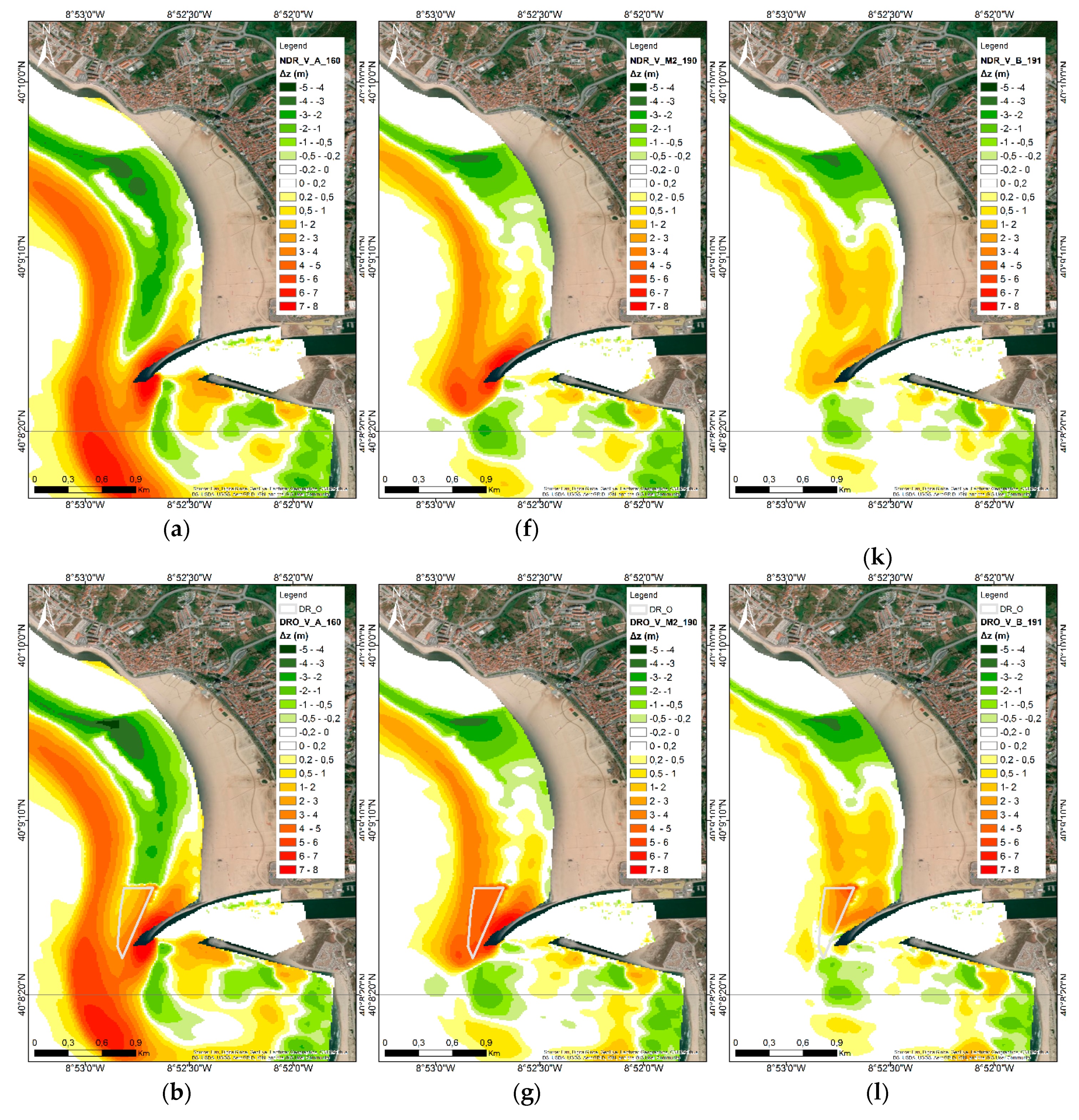
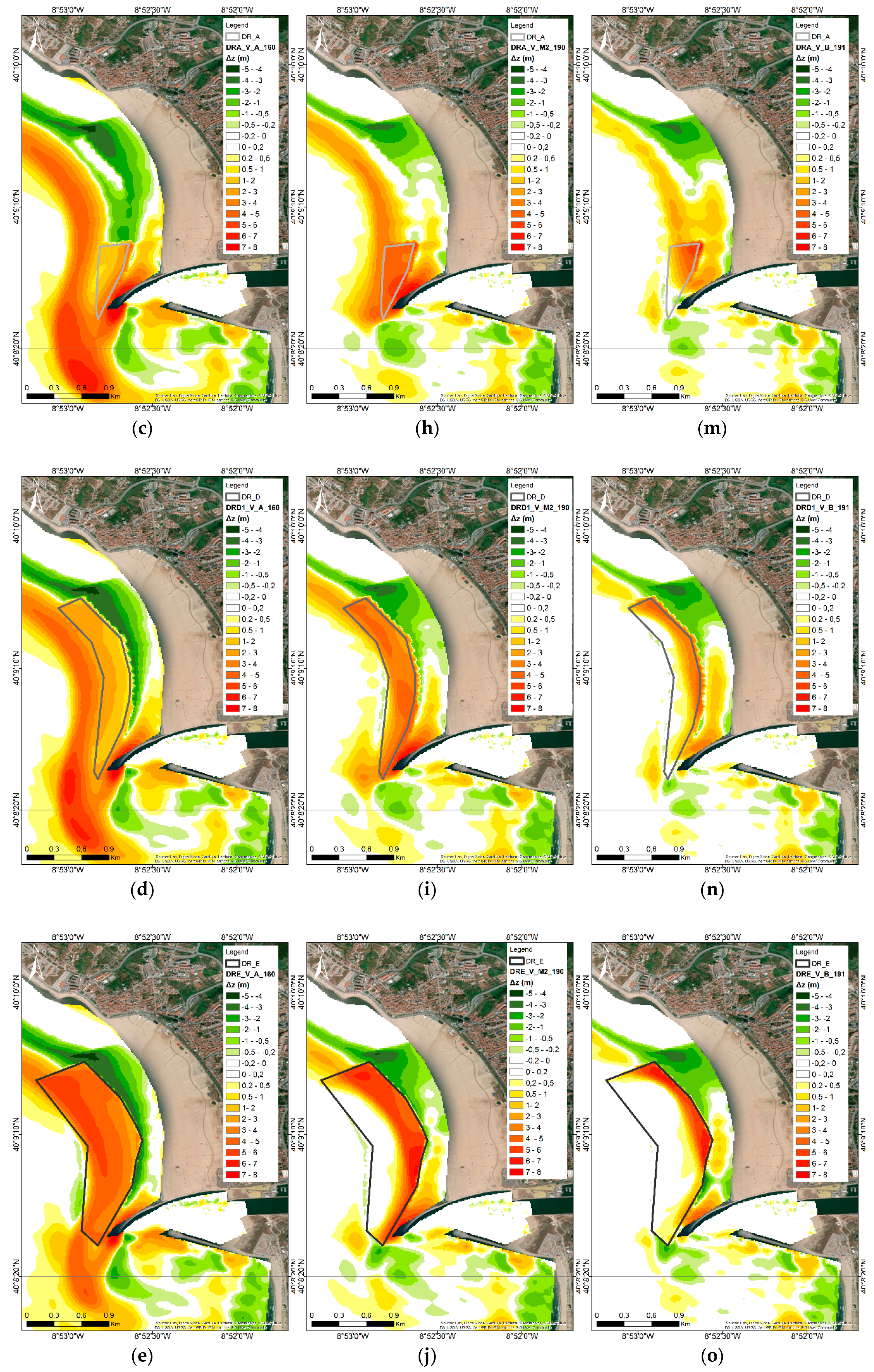

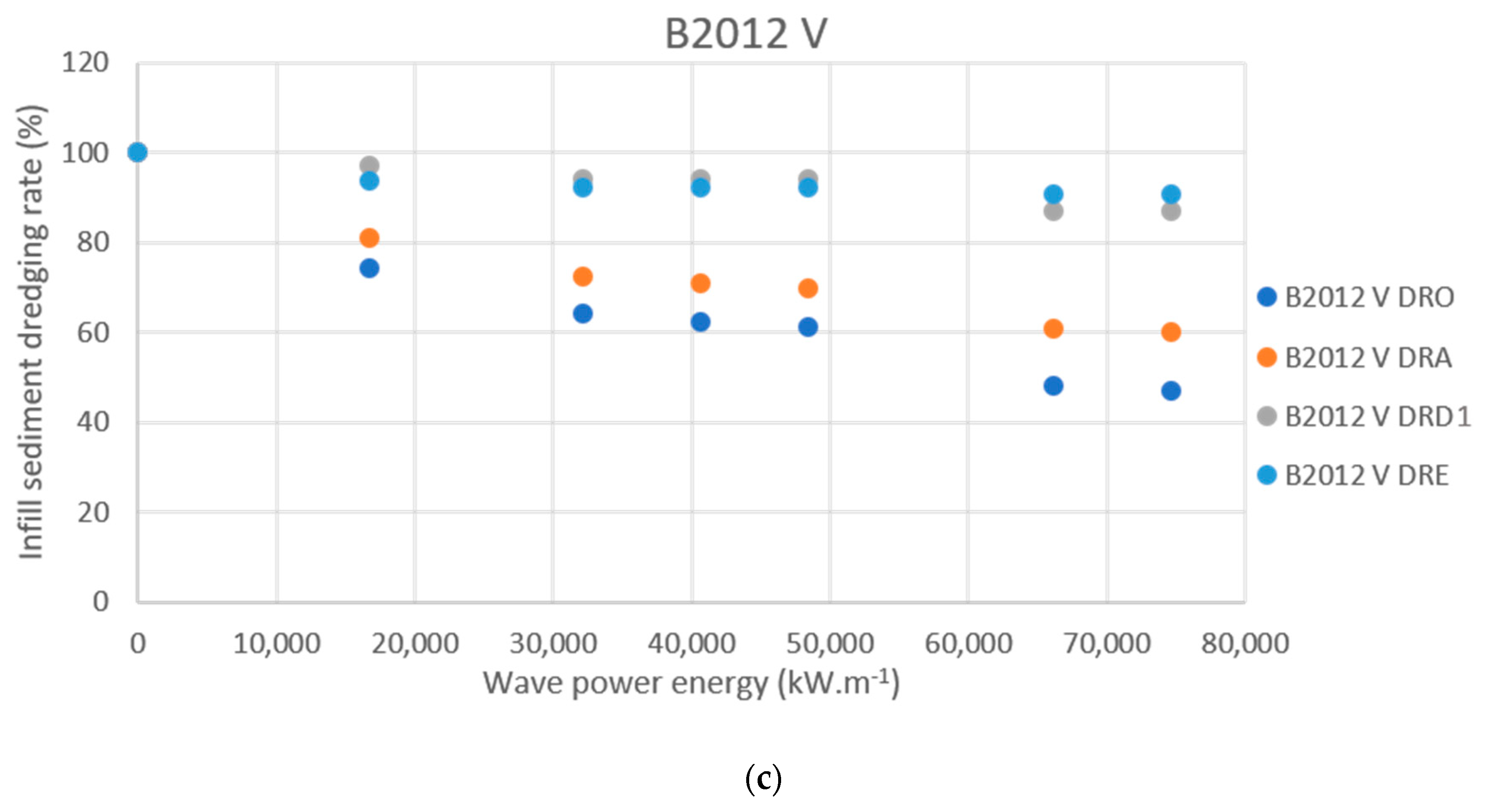
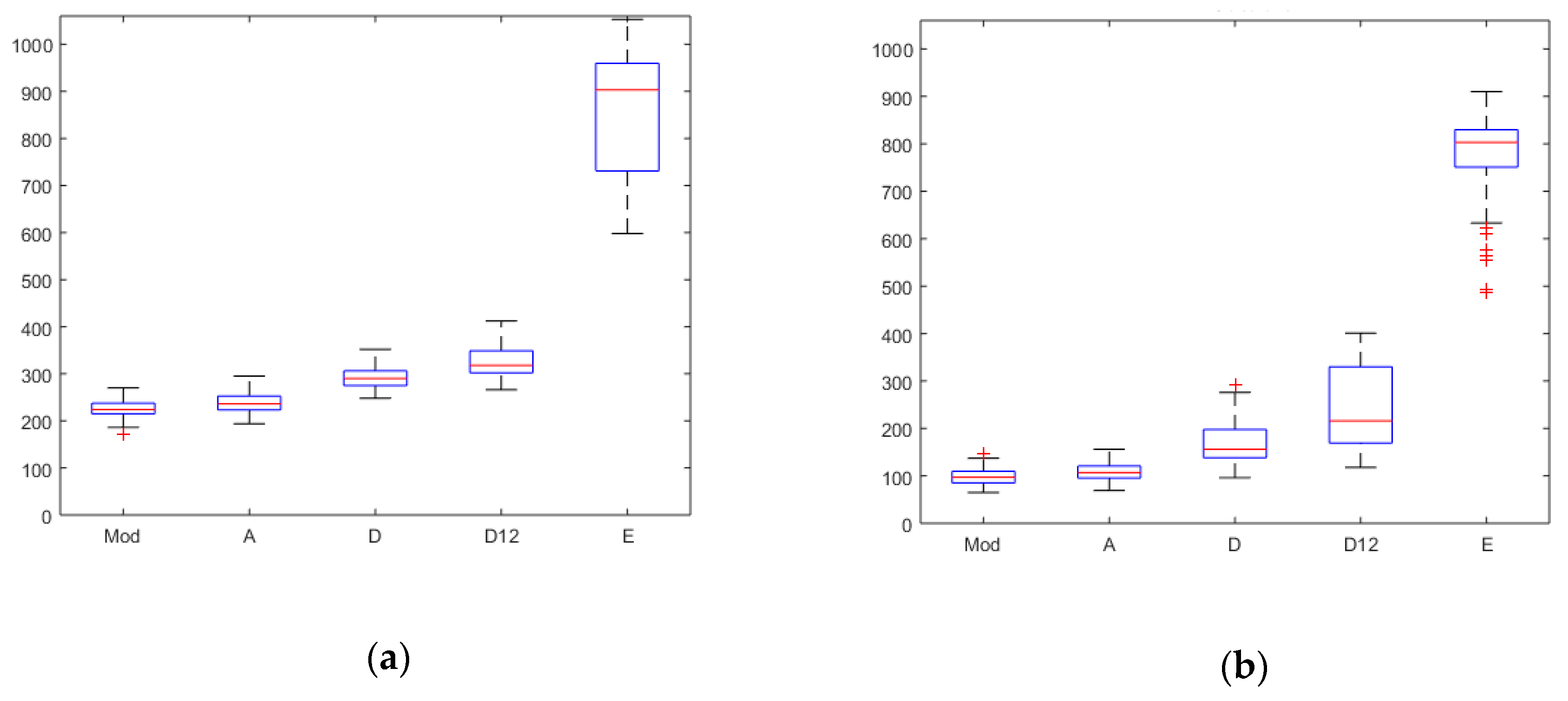
| Year | Day | Month | Duration (h) | PSI (m2·h) | Hsmax (m) | Tp (s) | Dir (°) |
|---|---|---|---|---|---|---|---|
| 2007 | 10 | January | 20 | 480 | 4.9 | 16.4 | 282 |
| 9 | February | 23 | 508 | 4.7 | 13.1 | 295 | |
| 10 | February | 53 | 2597 | 7.0 | 17.6 | 295 | |
| 22 | February | 56 | 2589 | 6.8 | 17.4 | 287 | |
| 5 | March | 41 | 868 | 4.6 | 14.0 | 293 | |
| 7 | March | 25 | 650 | 5.1 | 13.3 | 313 | |
| 19 | March | 47 | 2238 | 6.9 | 15.7 | 341 | |
| 2012 | 2 | January | 32 | 677 | 4.6 | 17.1 | 312 |
| 26 | January | 23 | 508 | 4.7 | 14.6 | 334 | |
| 8 | March | 24 | 576 | 4.9 | 18.8 | 323 | |
| 2014 | 13 | January | 27 | 571 | 4.6 | 13.8 | 298 |
| 15 | January | 74 | 2754 | 6.1 | 14.6 | 297 | |
| 19 | January | 12 | 232 | 4.4 | 12.1 | 315 | |
| 22 | January | 17 | 344 | 4.5 | 14.7 | 320 | |
| 26 | January | 102 | 4856 | 6.9 | 16.1 | 315 | |
| 1 | February | 253 | 18279 | 8.5 | 14.3 | 286 | |
| 14 | February | 63 | 3176 | 7.1 | 14.8 | 285 | |
| 17 | February | 31 | 838 | 5.2 | 15.7 | 292 | |
| 22 | February | 16 | 310 | 4.4 | 14.9 | 307 | |
| 23 | February | 22 | 528 | 4.9 | 15.4 | 267 | |
| 25 | February | 27 | 730 | 5.2 | 14.8 | 301 | |
| 28 | February | 42 | 968 | 4.8 | 14.0 | 304 | |
| 3 | March | 48 | 3468 | 8.5 | 16.2 | 311 | |
| 25 | March | 33 | 760 | 4.8 | 13.3 | 315 | |
| 31 | March | 16 | 369 | 4.8 | 10.9 | 218 |
| Winter Climate Scenarios | High (2014) | Medium (2007) | Low (2012) | |
|---|---|---|---|---|
| Coastal Dredging Scenarios | Reference (NDR) | x | x | x |
| Dredge_O (DRO) | x | x | x | |
| Dredge_A (DRA) | x | x | x | |
| Dredge_D_1 (DRD1) | x | x | x | |
| Dredge_D_2 (DRD2) | N.P. | x | N.P. | |
| Dredge_E (DRE) | x | x | x |
© 2019 by the authors. Licensee MDPI, Basel, Switzerland. This article is an open access article distributed under the terms and conditions of the Creative Commons Attribution (CC BY) license (http://creativecommons.org/licenses/by/4.0/).
Share and Cite
Fernández-Fernández, S.; Ferreira, C.C.; Silva, P.A.; Baptista, P.; Romão, S.; Fontán-Bouzas, Á.; Abreu, T.; Bertin, X. Assessment of Dredging Scenarios for a Tidal Inlet in a High-Energy Coast. J. Mar. Sci. Eng. 2019, 7, 395. https://doi.org/10.3390/jmse7110395
Fernández-Fernández S, Ferreira CC, Silva PA, Baptista P, Romão S, Fontán-Bouzas Á, Abreu T, Bertin X. Assessment of Dredging Scenarios for a Tidal Inlet in a High-Energy Coast. Journal of Marine Science and Engineering. 2019; 7(11):395. https://doi.org/10.3390/jmse7110395
Chicago/Turabian StyleFernández-Fernández, Sandra, Caroline C. Ferreira, Paulo A. Silva, Paulo Baptista, Soraia Romão, Ángela Fontán-Bouzas, Tiago Abreu, and Xavier Bertin. 2019. "Assessment of Dredging Scenarios for a Tidal Inlet in a High-Energy Coast" Journal of Marine Science and Engineering 7, no. 11: 395. https://doi.org/10.3390/jmse7110395
APA StyleFernández-Fernández, S., Ferreira, C. C., Silva, P. A., Baptista, P., Romão, S., Fontán-Bouzas, Á., Abreu, T., & Bertin, X. (2019). Assessment of Dredging Scenarios for a Tidal Inlet in a High-Energy Coast. Journal of Marine Science and Engineering, 7(11), 395. https://doi.org/10.3390/jmse7110395






